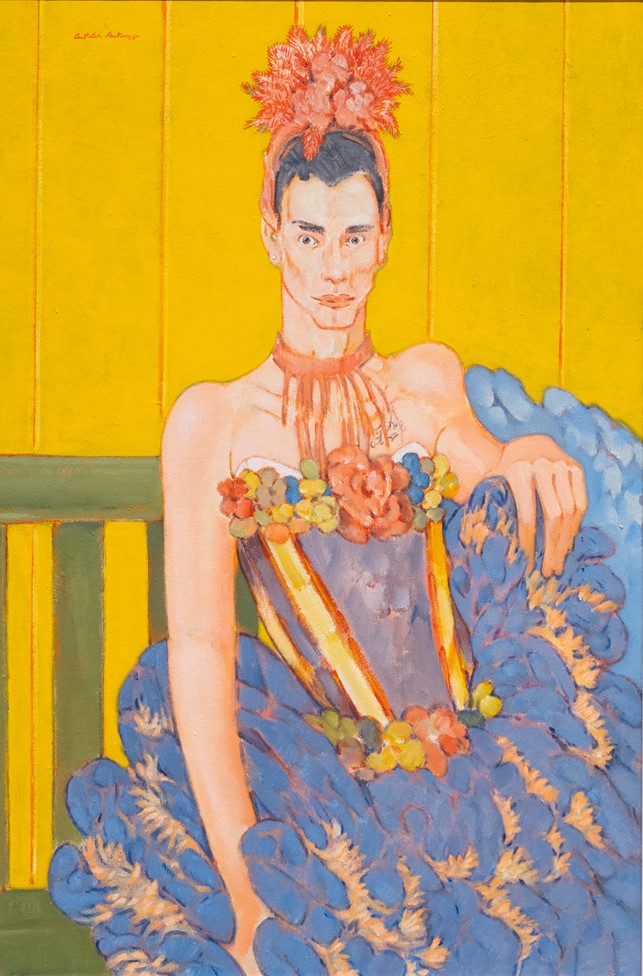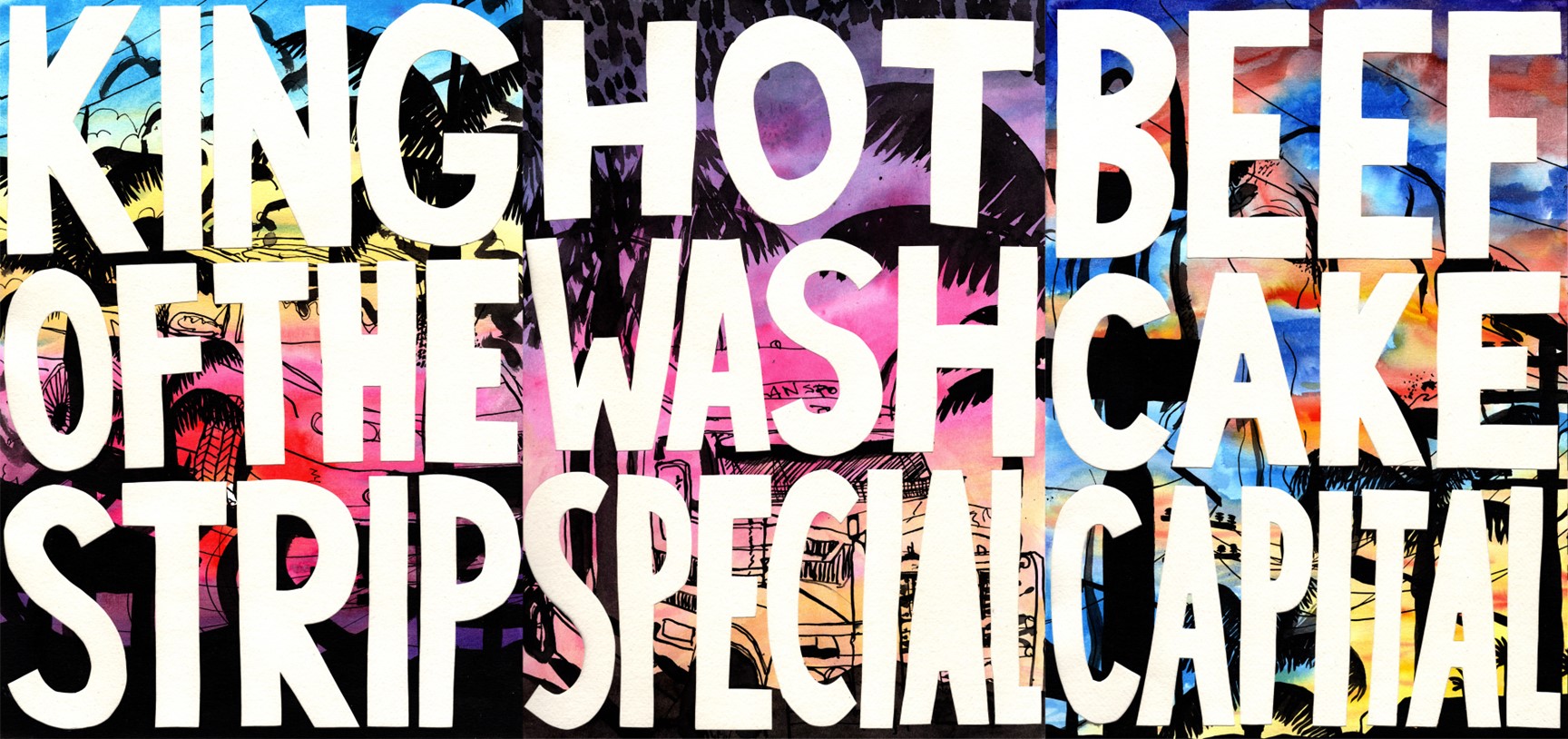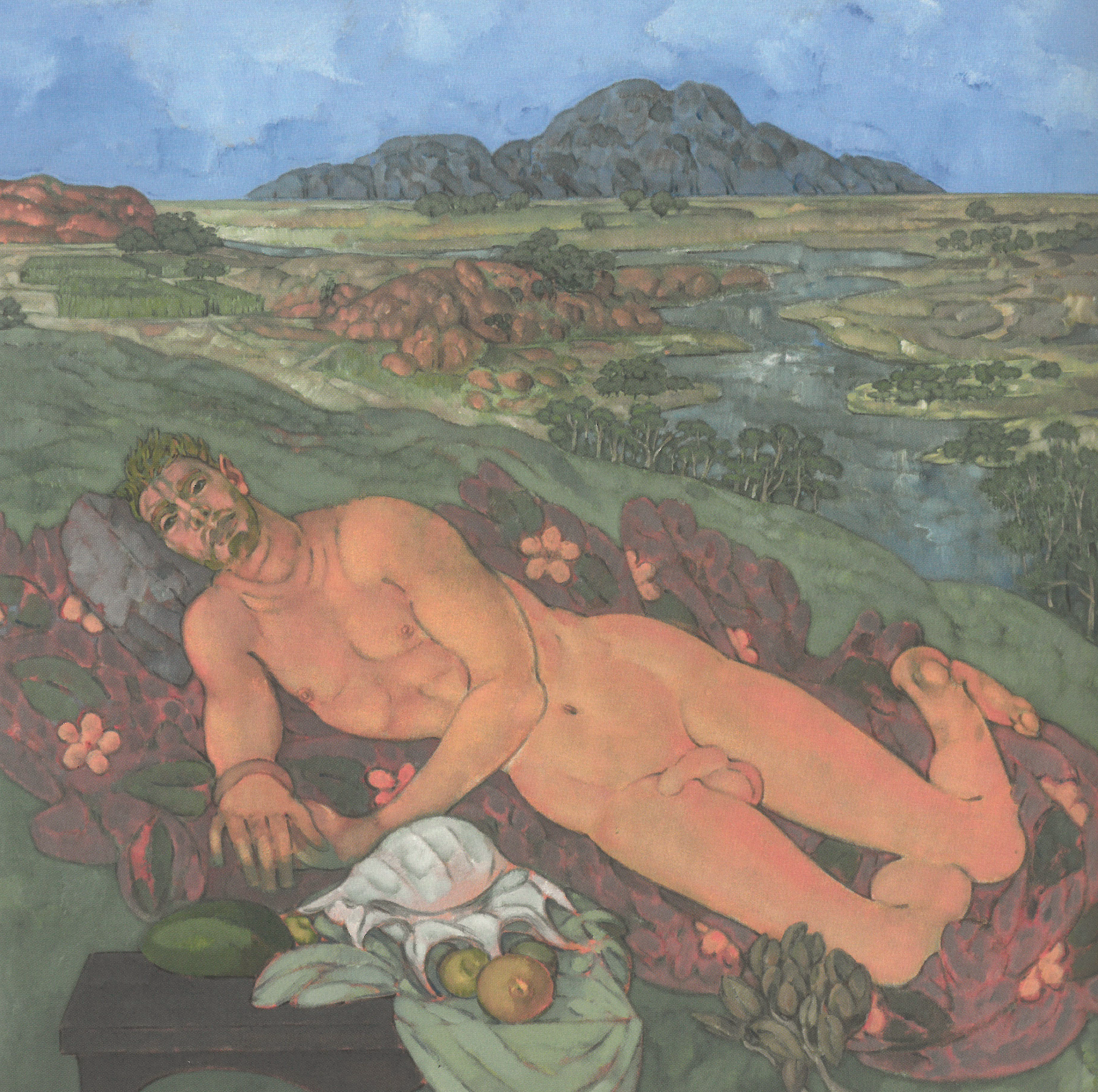Out Here: Cutler Footway and Easton Dunne at Rockhampton Museum of Art
Written by Emily Wakeling
Curator, Rockhampton Museum of Art
Download PDF here:
We at Rockhampton Museum of Art are delighted to host two concurrent exhibitions of artists from regional Queensland; two very different artists but both identifying as Queer and part of the LGBTQIAP+ rainbow.[1] In Gallery 1, ‘From a Burdekin Studio: Works by Cutler Footway’ is a close study of the landscapes, still lifes and figurative nudes by a North Queensland painter. In Gallery 2.2, ‘Easton Dunne: Welcome to Paradise’ is a solo exhibition of camp deconstructions of regional life by a Central Queensland-born artist.
With these exhibitions, the Rockhampton Museum of Art aims to embrace the many faces of queerness of our region; emphasising the ‘queen’ in Queensland, if you will. It’s a time for RMOA to especially make LGBTQIAP+ members of our communities more visible and welcome all genders and sexualities into our building and its programming.
As the experiences of people who identify as lesbian, gay, bisexual, transgender and intersex become more widely understood and enfolded within contemporary culture, the diversity of Queer expression and identity has broadened more and more. This social progress also inevitably comes with implications regarding space too; with a higher visibility stretching from metropolis to suburbia, and also reaching to more regional and rural settings as well.
The overwhelming geographical size and diversity of this continent brings different challenges and advantages to Queer people living non-metropolitan lives. For the authors of Queering the Countryside, the ‘spatial politics of gender and sexuality are enormously complicated…not because [space] is so powerfully determinative, but because its effects are so wildly unpredictable.’[2] The frequently pictured dichotomy between conservative country versus progressive metropolis has just as many contradictions as it has affirmations. It is true that many young LGBTQIAP+ people of regional Queensland aspire to move to big cities as soon as they come of age. This was the case for the two artists of focus, Cutler Footway and Easton Dunne. But both have also described a certain freedom in their childhoods, living within small and familiar networks of family and friends. And both have also, after a while, returned to regional settings.

Cutler Footway (b. 1952), Jack Betteridge – Debut 2019, acrylic on canvas, 90 x 60 cm. Photo: Bryce Millar, Mad Dog Productions.
Cutler Footway is the artistic pseudonym for art critic Bruce James, who left his hometown of Ayr on Bindal and Juru Country as a young gay man. He moved to Gurambilbarra/Townsville, Meanjin/Brisbane, and eventually to Eora/Sydney, where he spent three decades. While James describes his childhood as ‘happy enough,’ there was always a feeling of not quite belonging. The feeling came from being a young artist with an aversion to sport, but also from a secret identity he lacked the words to articulate. ‘I could not claim, as a result, to know what it was like growing up queer,’ says the artist. Once James found popular culture that he could relate to, the vocabulary helped him find an identity. ‘Culture, can I say, made me queer. Or rather, it was culture that made me realise that I was queer,’ says the artist.[3] Alongside many creatives, he felt the need to escape the Joh Bjelke-Petersen state government’s oppressive ‘deep north’ era of the late 1970s and into the 80s. As well as the regime’s outright hostility to women’s liberation and the anti-Vietnam War movement, homosexuality in Queensland was both a crime and a social liability.
Easton Dunne was born in 1990, one year before homosexuality was decriminalised in Queensland. It was also 13 years before being transgender was no longer considered a mental disorder by officially written medical standards. Growing up on a rural cattle station on Wadja Country, Central Queensland in the 1990s and 2000s, Dunne describes their childhood as having ‘wonderful times,’ where their parents allowed all children ‘lots of freedom to be ourselves, and that was precious to me as a young Queer, trans and non-binary child.’[4] Even as recently as the 2000s, Dunne describes a similar lack of representation and language–also experienced by James in the 1960s–that limited their understanding of their Queer identity while growing up. ‘I didn’t know that being Queer was an “option”,’ explains the artist, ‘the main difficulty growing up as a Queer child in rural Central Queensland was the invisibility of queerness.’ Once Dunne began schooling away from the isolation of their family’s cattle property, they innately took in popular culture that spoke to them personally that offered alternatives to cisgender and hetronormative narratives. At the same time, they also felt the pressure to conform to the Catholic gender confines of boarding school.

Easton Dunne (b. 1990), Meat Market (detail) 2023, ink and watercolour on paper, dimensions variable. Image courtesy the artist.
Bruce James found success in Sydney, in his profession and his identity. He was able to draw strengths from that sensitive and creative personality in the arts, rather than bear it as a liability, and found friendships and important social experiences within Sydney’s large gay community. However, ‘returning to Queensland was probably always my destiny….the call of the north was strong, deep and not to be denied.’ Easton Dunne underwent tertiary studies in Brisbane, in a move that promised ‘a ticket away from other people’s judgment’ at universities in which they were able to connect with the LGBTQIAP+ community. However, despite making connections with Queer peers, they felt out of place in typically Queer spaces including bars and nightclubs. ‘I was out of step with [other Queer people’s] level of confidence that many displayed because I hadn’t had a chance to grow into my identity yet.’ Dunne took a job offer in Rockhampton and has been living in the area since 2014.
For James, the experience elsewhere had helped him shed the secrecy surrounding his sexuality. Times had progressed enough for him, in 2003, to return to Ayr and navigate regional Queensland life as an out gay man. He created a safe space in the form of a home studio, filled with colour, light, beautiful objects, and his many life-drawing models. One of whom, Jack Betteridge, another out gay man, describes James’s Ayr studio as ‘like stepping into another world.’[5]
Under the moniker Cutler Footway, James paints his version of the Burdekin. It’s a beautiful place, with epic rock formations and green hills, filled with flowers and fruits, and populated by clothed and naked muses. It’s also filled with the suggestion of unease and danger that come with being exposed and vulnerable. In one painting, Wetland with Lovers and Crocodile 2006, two figures of non-specific gender are in the midst of a sexual act while a crocodile lurks in the water nearby. Above them, a tree had been struck and split by lightning. Out in the open, there is every chance the couple will be spotted, or worse, attacked. In Mark K, in the Burdekin 2017-18, Cutler Footway flips conventions for the reclining nude in classic painting. His model lounges on a rug; naked, flaccid, gazing away and totally at ease, while the viewer overlooks a vast river and mountains in the distance. This is not the Burdekin of postcards or agricultural reports–this is the Queer lens of Cutler Footway.

Cutler Footway (b. 1952) Mark K. in the Burdekin 2017-18, acrylic on board, 120 x 120 cm.
Dunne’s new exhibition ‘Welcome to Paradise’ is described by the artist as among their most unfiltered of artistic expressions. It’s one of the first bodies of work to be produced since they have come out as transgender and non-binary. Previous to this new body of work, Dunne exhibited a large-scale drawing of their long-term romantic relationship, Drawn Together, which was a first step in no longer ‘self-censoring,’ to use the artist’s description. ‘Up until that point, I self-censored queerness from most of my early work because I thought it would alienate audiences and jeopardise my employment because of the religious freedom caveats in the Anti-Discrimination Act.’ However, the stress that came with displaying queer artwork while employed at a school with religious affiliation took most of the enjoyment out of sharing their identity. After feeling compelled to leave teaching in order to be able to transition socially and medically in late 2021, Dunne has been ‘reunited with my ability to experience and express rage, anger, pain and frustration;’ things typically not permitted for people who are Queer or assigned female at birth. ‘I am finally able to examine my experiences as a Queer person explicitly through my work, and it feels essential that I do so for my wellbeing as an artist and individual,’ says Dunne.
Dunne embraces an encoded queerness in ‘Welcome to Paradise,’ artworks dedicated to the lexicon and visual aesthetics of country and coastal Central Queensland. It is a thoroughly camp treatment of Dunne’s childhood, including the performative masculinity of bull riding and drag races; the absurdism of Jesus’ ecstatic torture on crucifixes hung in family lounge rooms; and the kitsch decor and glitter of the feminine realm. Most prominent is their use of bright pink fur, used in the manner of cowhide, to decorate a whole wall of silhouette icons of Central Queensland, ranging from bulls and cars to prawns and palm trees.

Easton Dunne (b. 1990), Welcome to Paradise 2022, synthetic fur, mdf, adhesive and timber. Image courtesy the artist.
After formative life stages in major capitals, both artists have now returned to regional Queensland with new perspectives. What this offers is alternative narratives, or at least more complex versions of the story. Usual depictions of Queer people growing up outside of an urban existence are often limited to that childhood yearning for escape (if money, class and health allow) to the big city—with Sydney being the ultimate destination. But Sydney no longer hosts the highest percentage of gay and lesbian couples per capita.[6] The ‘gaybourhoods’ are rapidly changing and moving. The latest census figures demonstrate the likelihood of LGBTQIAP+ people living in regional locations, in comparison to urban centres, is becoming more visible. This includes Queensland, and it includes Rockhampton. Hopefully, this demographic shift is reflecting better conditions for Queer people outside of the capitals; the figures might indicate that the option of staying closer to hometowns—and the family support, housing, employment and education advantages this or other regional locations could offer—is becoming a more realistic choice for more and more people.
To have both exhibitions concurrently held here at Rockhampton Museum of Art offers audiences the opportunity to see Queer regional life on the gallery walls in two quite different expressions. Australia is geographically vast—and so are its demographics. In its vastness, the terms ‘rural’ and ‘regional’ cover a complex assemblage of people, places, cultures and communities—almost as big as the term ‘Queer’ itself.
‘From a Burdekin Studio: Works by Cutler Footway’ 1 April – 2 July 2023
‘Easton Dunne: Welcome to Paradise’ 20 May – 23 July 2023
Rockhampton Museum of Art
[1] The term ‘Queer’ is not accepted by all LGBTQIAP+ (lesbian, gay, bisexual, trans, queer/questioning, intersex, asexual/aromantic, pansexual plus) people. Some consider it harmful because of its other context as a slur—less common now but with a long and harmful history. The term is used in this essay because it is specifically identified with by both of the essay’s subjects.
[2] Gray, Mary L, Johnson, Colin R & Gilley, Brian J (eds.) Queering the Countryside, New York University Press, 2016, p.7
[3] Communications with the artist, 17 February 2023.
[4] Communications with the artist, 7 February 2023.
[5] Conversation with Jack Betteridge, 15 December 2022.
[6] In fact Cairns hosts one of the highest percentages of same-sex couples in the nation. Mannheim, Markus Canberra, Not Sydney, is the Gay and Lesbian Capital of Australia, ABC News, 13 November 2019, https://www.abc.net.au/news/2019-11-01/canberra-the-gay-and-lesbian-capital-of-australia/11650758